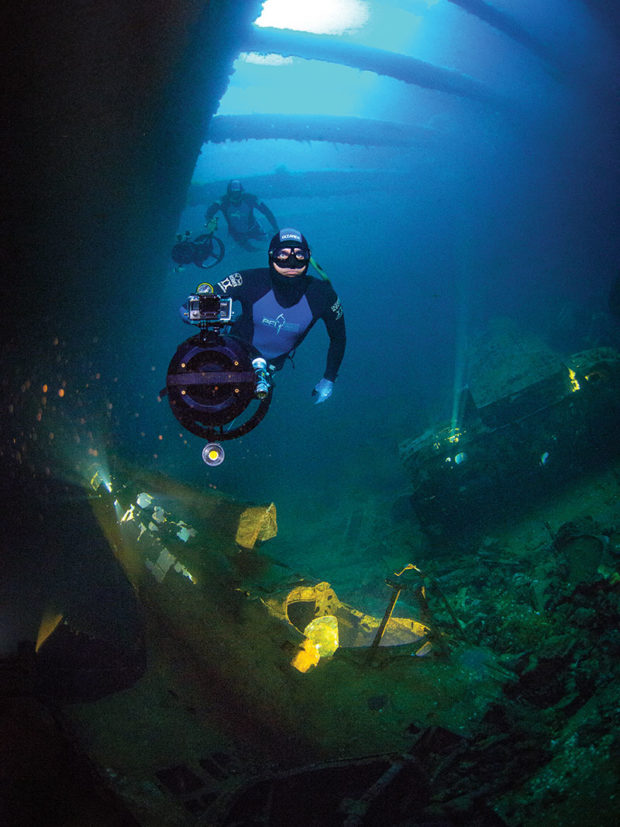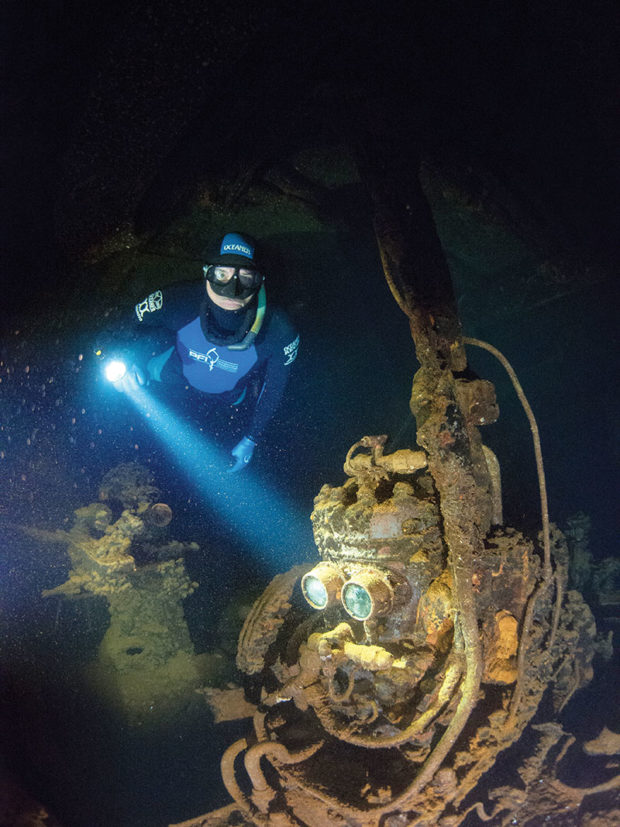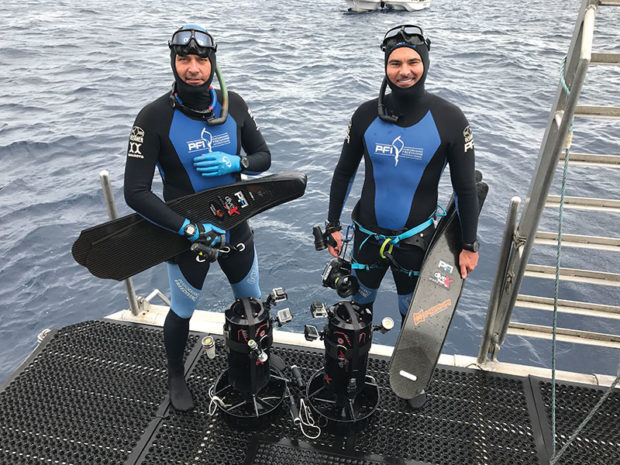Technical Freediving in Truk Lagoon
By Kirk Krack and John Hullverson
https://vimeo.com/201936642
To my mind, there’s nothing better than gliding over a reef or wreck, free of tanks and hoses, tied only to the surface by my need for an eventual gulp of air.
However, as a former Trimix Instructor Trainer from what seems like a lifetime ago, I’ve also enjoyed another side of diving; one where I stayed at depth for long durations with tanks, sometimes six of them dangling off me, hoses snaking their way around my body as I finned to the rhythmic release of my bubbles, all the while alarms chirping and LED’s flashing my progress towards my eventual surfacing through stages of boredom during decompression. I’m not knocking anyone who enjoys this, but I wasn’t saddened to give it all up when the opportunity of follow my life-long passion for breath-hold diving/freediving presented itself in 1997. I’d eventually form my company, Performance Freediving International (PFI), in January of 2000, dedicating myself to ‘Explore Your Potential, Safely Through Education’, which has been our motto since that time.
Twenty years later I’ve started to look back on that technical/trimix diving background, to utilize that education and experience as I develop a new form of freediving, combining freediving with underwater diver propulsion vehicles; putting it all together at one of the world’s best wreck diving playgrounds in what would be a freediving expedition to Truk Lagoon.
“We developed a plan to freedive Truk like had never been done before, using scooters, enriched oxygen mixtures and 100% O2 at the surface”

Freediving Truk?
Since becoming a dive instructor in 1988 I’ve wanted to explore Truk Lagoon. Five or so years ago I even tried to put together an expedition to ‘scooter freedive’ Truk, but I was met with skepticism regarding the cost, in addition to the idea of breath-holding on and through wrecks, some of which lie in excess of 200 feet (60m) of depth. While a “touch-and-go” freedive to 200 feet (60m) is one thing, having quality time at depth to meaningfully explore these wrecks is quite another, and would require some creativity and planning. Our objective was not just to freedive the wrecks of Truk Lagoon, but also to explore and capture the experience with long bottom times, to enjoy the outside, and (albeit more limitedly) the insides as well. Most importantly, to do it safely with procedures and protocols, back-ups, and redundancies. I’m not one to take risks without first working through the risk analysis of it. I have a family to go home to.
In January 2017, John Hullverson and Chris Bustad, executive and staff instructors at PFI, and I joined with a good friend who leads the safety rebreather team at our annual freediving training camp and competition Deja Blue, Bill Coltart of Pacific Pro Dive. For some time Bill had been suggesting a combined trip with technical rebreather divers and freedivers. We jumped on the idea and started putting a plan into action: a joint expedition with some of the best in technical rebreather divers and freedivers to Truk Lagoon, in modern day Chuuk State, Micronesia.
Truk Lagoon was the site of a decisive WWII battle, in which US planes sank an entire armada of Japanese ships in the shallow waters of this atoll lagoon and destroyed hundreds of Japanese aircraft on the ground and in the air. Truk is regarded as the best-preserved battleground wreck diving site in the world. Scores of ships and planes lie mostly intact and undisturbed in less than 215 feet (65m) of water, filled with cargo including fighter aircraft, tanks, bulldozers, railroad cars, motorcycles, torpedoes, mines, bombs, boxes of munitions, radios, thousands of various weapons, human remains, and other artifacts. The ships themselves serve as artificial reefs and the amount of sea life is astounding.
“These new protocols allowed us to reduce surface intervals by upwards of 40%, allowing us more freedives”
The right tools
Freediving the shallower wrecks looked pretty straightforward. We could simply kick to moderate depths, 65-130 feet (20-40m), staying there for around 2-3 minutes – and maybe the occasional 4min freedive if we spent more surface time prepping and used lines to pull down, employing what we call ‘free immersion’. However in a typical 2min freedive to 130 feet (40m), descending and ascending at 1m/s really only leaves you about 40sec at depth if you’re moderating your workload. Realistically, in the 130-200ft+ (40-60m+) zones this would only allow a touch’n go with no time for exploring and filming. Along with this, a 130-foot (40m) freedive requires a minimum 8min surface interval and deeper than that might require 14-20min surface intervals. In the course of a day we would be leaving a lot of the wreck unexplored as our bottom times would be limited and number of dives in a day would be small. Exhaustion would take its toll over 10 days. We needed to employ the right tools for the job.
So we developed a plan to freedive Truk like had never been done before, using scooters, enriched oxygen (O2) mixtures and 100%O2 at the surface, employing new surface interval protocols for air, and accelerated surface intervals when using high % O2 mixtures. All of this would allow us to get to depth faster and with effectively no effort, explore longer, and enjoy more freedives with less required surface interval. We could cover the whole wreck in two to three dives, and some in one dive alone; this would allow us to scout and then hone in on a area of interest where we may spend a dozen dives or more.
I’ve always enjoyed scooter freediving. It’s like jumping on a motorbike and going touring, rather than lacing up your hiking boots and putting on your back pack and walking through the forest, which is more in line with freediving.

For the last several years, we’ve been utilizing Dive Xtras’ Piranha scooters at our annual training camp and competition Deja Blue in Grand Cayman. Weighting less than 35lbs (16kg), the Piranha is fast, durable, and reliable; and the dry-cell battery allows us to fly with them. Scooters allow us to provide deep safety to all our athletes on their dives via a scooter safety freedivers who accompany the competitor nearly the full length of their dive, down to at least 200 feet (60m), and often deeper than that.
In Truk John, Chris, and I each had our own scooter outfitted with GoPro’s, both forward and back facing. We’d be relying on Suunto D9’s and D4’s as our main computers and back-ups allowing us accurate depth/time, pre-set depth and time alarms for important reminders, and surface interval calculations that would be critical in avoiding any DCI issues. The scooters would allow us to get to depth effortlessly at over 2m/s. We’d be able to double our bottom times. Not only would our functional bottom times be increased, but also the work of getting down and back would be removed. This would allow for a more relaxed time to venture around and explore. As always, we would strictly adhere to the most important rule with a scooter: ‘never go deeper or stay longer than you couldn’t ditch the scooter and ascend self-powered’, and make sure you ascend where you descended, so your safeties are there.
We also planned to implement a ‘technical freediving’ regime; this breath-hold diving while using enriched oxygen (O2) mixtures as surface breathing gasses helps flush nitrogen and increase the availability of oxygen to the tissues. When used before and/or after a freedive, enriched O2 mixtures (most commonly Nitrox 32% or 36% pre-dive and 100% 02 post-dive) can reduce fatigue, decompression stress, and surface intervals, while both increasing breath-hold times and speeding recovery. Conceptualizing this idea in the mid-90’s, PFI has been testing these protocol for several years with our Deja Blue safety freedivers utilizing pre-dive Nitrox with great success. A huge advantage was using 80% and higher oxygen mixtures in combination with our new surface interval protocols. These new protocols allowed us to reduce surface intervals by upwards of 40%, allowing us more freedives per session and less fatigue at day’s end, and removed any decompression stress.
“On Rio De Janeiro Maru, which sat in 115 feet, I did some relaxed scooter sightseeing for a total time of 5:46”

The expedition
After a pretty manageable flight, we arrived on Truk and were soon aboard our floating home for the next ten days—Master Liveaboard’s Truk Master. This 121-foot (37m) dive yacht was perfect for our needs: comfortable cabins, super friendly and attentive Captain and crew, plenty of space for all the various cameras and equipment, gas blending with O2 and helium for the technical divers, and an executive chef intent on making our trip a weight-gainer. New crewmember Aron Arngrimsson, who was mixed gas rebreather instructor and could blend our gases and understood the technical diving and tech diving language, quickly became invaluable.
Over the course of ten dive days, we dived on 17 wrecks, from 3,700 ton merchant ships like the Nippo Maru, to Japanese Zeros and Betty Bombers, and even a sunken submarine that still contains the remains of the unfortunate crew who all perished when their commander, fearing an imminent air attack, ordered the sub to dive before all the hatches were closed.
During our dives around and into the holds of these wrecks, we saw tanks, trucks, a bulldozer, land mines, millions of machine gun bullets, crates of beer bottles, a whole range of machinery, supplies and personal effect such as medicine bottles and fine china dinnerware. And yes, even human remains, which served as a sobering reminder that the wrecks we were enjoying were sunk during a ferociously intense battle that must have seemed like hell on earth to the men onboard.
Dive days began with the Captain briefing us on the particular wreck we’d be diving, followed by a “team meeting” between the freedivers and rebreather crew to go over the specific dive and safety plans we’d be following.
Next, it was out onto the huge dive deck to suit up and get our equipment prepared for the dive. For technical freediving, that included analyzing tanks to ensure the proper mix of gases we’d be breathing before and after our dives.
Our rig consisted of two sturdy Gannet floats supporting a 16-foot (5m) carbon-fiber bar that served as our “home base” in the water. Attached to the carbon-fiber bar were mounts for the two tanks: one Nitrox for pre-dive breathe-up and one 02 for post dive surface recovery. We attached the rig to the mooring buoys, which usually led to the to deck or King posts of the wrecks.
After a suitable warm up, John, Chris and I took turns exploring the amazing underwater playground. One important note about safety: technical freediving and freediving in overhead environments, such as the interior of sunken wrecks, requires specialized knowledge, training, expertise, and planning and should not be attempted in the absence of any of these factors.
Our typical dive began with an appropriate surface interval followed by a breathe-up and peak inhalation taken directly off the Nitrox regulator. The scooters allowed us to get down to the wrecks usually within about 20 seconds, and from there we followed a predetermined plan of exploration of the wreck, usually either a tour of the deck, which usually held equipment like tanks and anti-aircraft guns, or an exploration of the interior holds and passageways of the ships, which held an amazing variety of cargo from airplanes and airplane parts, to landmines, to torpedoes and periscopes.

The technical freediving and scooters had their intended benefits and we were excited to be enjoying dives of more than three minutes with complete ease even though we were working somewhat aggressively, filming and exploring. That’s a significant amount of time observe our surroundings and the scooters allowed us to cover a lot of territory. It was not uncommon that we could completely circumnavigate these large vessels on a single dive. Ultimately freedive times averaged around 3:00-3:45, with 2:00-2:45 of that being ‘bottom time’ in the 130-200 foot (40-60m) range. One circumnavigation of the Rio De Janeiro Maru, which sat in the 115-foot (35m) range, I did some relaxed scooter sightseeing for a total time of 5:46, while another dive allowed a lazy bottom exploration of 6:08 at 101 feet (31m).
Some of the highlights of our trip included exploring deep inside the various engine rooms (always keeping a clear view of the route to the blue water outside) as well as zooming down the outer gangways to explore the whole length of the ship. It was fascinating, viewing the torpedo holes in the hulls or massive bomb craters in the decks that brought these enormous ships to the bottom. On our last dive day, John and I dived the Hoki Maru, a 450-foot (137m)-long merchant ship resting at 165 feet (50m) deep. Our protocols had proven their worth. Over the 10 days we successfully completed, to our knowledge, the first freedive expedition of the famous Ghost Fleet of the Truk Lagoon.
The wrecks of the Truk Lagoon offer a huge variety of options for divers to explore an important part of WWII naval history. We’re already planning our return trip in 2019.







